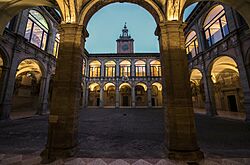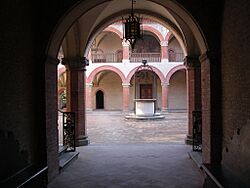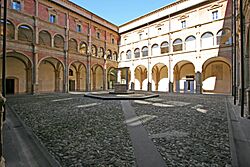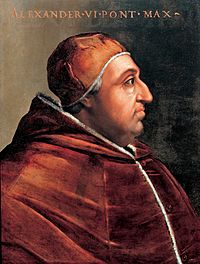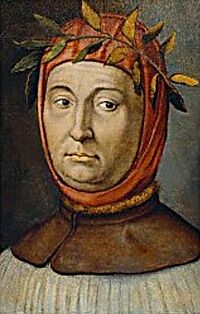University of Bologna facts for kids
|
Alma Mater Studiorum – Università di Bologna
|
|

|
|
| Latin: Universitas Bononiensis | |
| Motto | Petrus ubique pater legum Bononia mater (Latin) |
|---|---|
|
Motto in English
|
St. Peter is everywhere the father of the law, Bologna is its mother |
| Type | Public research university |
| Established | c. 1088 |
|
Academic affiliations
|
|
| Rector | Giovanni Molari |
|
Academic staff
|
2,917 |
|
Administrative staff
|
2,965 |
| Students | 90,291 |
| Undergraduates | 47,253 |
| Postgraduates | 36,266 |
| 4,239 | |
| Location |
,
Italy
44°29′38″N 11°20′34″E / 44.49389°N 11.34278°E |
| Campus | University town 103 hectares (256 acres) |
| Colours | Red |
The University of Bologna is a public research university located in Bologna, Italy. It is known as the oldest university in the world that has been open without stopping. It was also the first place to give out university degrees. Teaching started around 1088. The university's symbol has the motto Alma Mater Studiorum, which means "Nourishing mother of studies," and the date "A.D. 1088."
With over 90,000 students, the University of Bologna is one of the largest universities in Europe. It was also home to some amazing women who broke barriers. Bettisia Gozzadini was the first woman to earn a university degree and teach there. Later, Laura Bassi became the first woman to get a science doctorate and a paid job as a university professor.
The University of Bologna played a big part in science during the Middle Ages and the Italian Renaissance. Famous thinkers like Nicholas Copernicus studied there. Many important people, including Italian scientists, prime ministers, judges, and priests, have studied at this university.
Besides its main campus in Bologna, the university has other campuses in Cesena, Forlì, Ravenna, and Rimini. It also has centers in other countries like Buenos Aires, New York, Brussels, and Shanghai. The university has a special boarding college called Collegio Superiore di Bologna, botanical gardens, many museums, libraries, and even its own publishing house.
Contents
A Look at History
The exact date the University of Bologna started is not fully known. In 1158, the Holy Roman Emperor Frederick I Barbarossa gave the university a special document called a charter. However, in the 1800s, a group of historians decided that the university actually began in 1088. This date makes it the oldest university that has been open continuously. But it's important to remember that the university grew slowly over time.
The university began with groups of foreign students who helped each other. These groups were called "nations" because students were grouped by their home country. They helped protect each other from local laws that could punish all foreigners for the actions of one person. These students then hired smart teachers from the city to teach them subjects like law and writing.
Over time, these student groups decided to form a bigger organization, which became the university. This gave them more power to negotiate with the city. Since many foreign students brought money to the city, the students could threaten to leave if they were not treated well. This helped them get more rights. They also negotiated with their professors about what would be taught and how much professors would be paid. Students even had a committee to check on professors and fine them if they didn't finish classes on time! Eventually, the city started paying the professors, and the university became a public institution.
The university is famous for teaching church law and civil law. It was created to study an important Roman law text called the Digest, which was found again in Italy in 1070. The university was key in developing medieval Roman law. For a long time, the only degree you could get there was a doctorate.
Pioneering Women in Academia
Bettisia Gozzadini made history in 1237 when she earned a law degree. She was one of the first women ever to get a university degree. She taught law from her home for two years, and then in 1239, she taught at the university itself. This made her the first woman in history to teach at a university.
Centuries later, Laura Bassi was born into a wealthy family in Bologna and was taught at home from a young age. Her intelligence was noticed by a local archbishop, who later became Pope Benedict XIV. He helped her arrange a public debate with four professors from the University of Bologna in 1732. Laura, who was only twenty, successfully defended her ideas on philosophy. On May 12, the University of Bologna gave her a doctorate degree. She became the first woman to receive a doctorate in science.
Later that year, in October 1732, the university hired Bassi as a professor of natural philosophy to teach physics. This made her the first woman in the world to have a paid university teaching job. She also became the first woman to join a scientific group when she was elected to the Academy of Sciences of the Institute of Bologna. Laura Bassi was very important in bringing Newton's ideas about physics to Italy.
How the University Works
Universities across Europe are working to make their education systems similar. Today, the University of Bologna offers many different types of degrees. There are 101 "first-level" degrees, which usually take three years to complete. After that, students can pursue 108 "second-level" degrees, which take two more years. Some special courses, like medicine, take five or six years in one continuous study program.
After a first-level degree, students can get a "first-level Master" diploma, which is a one-year program. After a second-level degree, they can go on to a "second-level Master," special training schools, or even work towards a research doctorate (PhD).
The university is organized into 11 main Schools:
- School of Agriculture and Veterinary Medicine
- School of Economics, Management and Statistics
- School of Engineering and Architecture
- School of Foreign Languages and Literature, Interpreting and Translation
- School of Law
- School of Arts, Humanities, and Cultural Heritage
- School of Medicine and Surgery
- School of Pharmacy, Biotechnologies and Sport Sciences
- School of Political Sciences
- School of Psychology and Education Sciences
- School of Sciences
These Schools are further divided into 33 departments, which focus on different areas of research and teaching.
Special Programs and Groups
Il Mulino Publishing
In the early 1950s, some students from the University of Bologna started a magazine called "il Mulino." Soon, this magazine became a very important place for discussions about politics and culture in Italy. In 1954, the "il Mulino" publishing house was founded, which is now one of Italy's most important publishers.
Collegio Superiore
The Collegio Superiore is a special program within the University of Bologna. It helps talented students by offering extra learning programs. It was started in 1998.
Students in the Collegio Superiore get an additional education path alongside their regular university degree. They take specialized courses that cover many different subjects. All students in this program receive a full scholarship, which means their studies are paid for. They also get help from a personal tutor and free housing. To stay in the Collegio Superiore, students must keep up their high grades in both their regular degree and the extra courses.
Famous People from Bologna University
Many famous people have studied or taught at the University of Bologna. Here are just a few:
Notable Alumni
- Dante Alighieri, a famous Italian poet and writer.
- Nicolaus Copernicus, who developed the idea that the Earth and planets orbit the Sun.
- Laura Bassi, the first woman to earn a university chair in a scientific field.
- Guglielmo Marconi, the Italian inventor and pioneer of radio.
- Enzo Ferrari, the founder of the famous Ferrari car company.
- Umberto Eco, a well-known Italian writer and philosopher.
- Petrarch, a famous Italian scholar and poet.
- Pope Alexander VI, a historical Pope.
- Carlo Goldoni, an important Italian playwright.
- Pierluigi Collina, a famous football referee.
- Stefano Domenicali, the CEO of Formula One Group.
Notable Faculty and Staff
- Irnerius, a founder of the School of Glossators (early law teachers).
- Bettisia Gozzadini, the first woman to teach at a university.
- Nicolaus Copernicus, who also taught at the university.
- Paracelsus, a founder of the study of toxicology.
- Giovanni Cassini, a famous astronomer.
- Marcello Malpighi, a pioneer in microscopic anatomy.
- Laura Bassi, the first woman to have a paid university teaching job.
- Luigi Galvani, known for his work on bioelectricity.
- Guglielmo Marconi, the radio pioneer.
- Umberto Eco, the writer and philosopher.
University Rankings
| University rankings | |
|---|---|
| Global – Overall | |
| ARWU World | 201–300 (2024) |
| CWUR World | 201 (2024) |
| CWTS World | 113 (2024) |
| QS World | =138 (2026) |
| THE World | =155 (2024) |
| USNWR Global | =130 (2024–25) |
The University of Bologna is highly regarded around the world. In the 2024 QS World University Rankings, it was ranked 154th globally. It was also ranked 73rd for its academic reputation, making it the 1st in Italy and 18th in Europe in that specific area. The same organization also placed it among the top 100 universities for how well its graduates find jobs.
In the 2024 Times Higher Education World University Rankings, the university was ranked 155th globally. In 2023, it was ranked 5th in Europe and 23rd in the world for its efforts in sustainable development, which means working towards the UN's goals for a better future.
For 14 years in a row, Bologna has been at the top of Italy's list of large public universities (those with over 40,000 students).
Places to Visit
- Orto Botanico dell'Università di Bologna (Botanical Garden of the University of Bologna)
- L'Orto Agrario "Filippo Re" (Filippo Re Agricultural Garden)
See also
 In Spanish: Universidad de Bolonia para niños
In Spanish: Universidad de Bolonia para niños
- Bologna declaration
- Bologna Process
- List of medieval universities
- List of universities in Italy
- Medieval university



